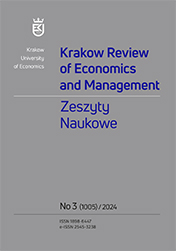The Research and Development Efficiency of Institutes of the Polish Academy of Sciences and the External Factors Affecting It
DOI:
https://doi.org/10.15678/krem.16719Keywords:
public research institutes, efficiency, R&D, DEAAbstract
Objective: The aim of the research is to assess the research and development efficiency of the institutes of the Polish Academy of Sciences (PAS) in 2019 and to identify external factors that have a significant impact on it.
Research Design & Methods: A two-stage procedure in the field of DEA methodology was used. In the first stage, the efficiency of PAS institutes was estimated using alternative BCC and SBM models. In the second stage, a Tobit model was used to isolate external factors significantly influencing efficiency. Given the data available, two types of research and development (R&D) efficiency were analysed: publishing efficiency and combined publishing and implementation efficiency.
Findings: A significant share of institutes are highly inefficient (nearly a half of the units in terms of publishing efficiency and a third in terms of combined efficiency). The fields in which a given scientific unit conducts research which significantly affect publication efficiency differ from those that significantly affect combined efficiency. Both types of efficiency are significantly negatively affected by the increase in the scientific category of the unit.
Implications / Recommendations: The source of high research and development inefficiency among a significant number of institutes is the fact that they also generate other outputs than those considered in the work. The majority of institutes do not apply to the R&D sphere. The significant negative impact of the increase in the scientific category on R&D efficiency indicates that future focus should prioritise the quality of publications over their quantity.
Contribution: The efficiency of the research and development activities of the PAS institutes was assessed after the introduction of the last reform of Poland’s system of science and higher education in 2018 (such studies have yet to be carried out). It is also important to use a two-stage approach within the DEA methodology in order to isolate external factors that significantly influence this efficiency.
Downloads
References
Banker, R. D., & Natarajan, R. (2008). Evaluating Contextual Variables Affecting Productivity Using Data Envelopment Analysis. Operations Research, 56(1), 48–58. https://doi.org/10.1287/opre.1070.0460 DOI: https://doi.org/10.1287/opre.1070.0460
Barcikowska, R. (2016). Instytuty badawcze w Polsce – próba syntetycznej oceny ich miejsca i roli w polityce innowacyjnej polski. MINIB, 21(3), 141–154.
Barcikowska, R. (2021). New Organizational Model for Functioning of Research Institutes in Poland – Comparative Analysis of Łukasiewicz and Poltrin Networks. Marketing of Scientific and Research Organizations, 39(1), 25–46.
Brzezicki, Ł. (2022). Działalność publicznych instytutów badawczych w Polsce. Nauki Ekonomiczne, 36, 35–83. https://doi.org/10.19251/ne/2022.36(2)
Brzezicki, Ł., & Prędki, A. (2022). Appendix 2022 PRI. Empirical Studies Using DEA Method and Malmquist Index to Measure the Efficiency and Productivity of PRI. https://doi.org/10.13140/RG.2.2.32913.30564
Brzezicki, Ł., & Prędki, A. (2023a). Appendix Table A1. A Review of Studies on the Impact of External Variables on the Level of Efficiency / Productivity in Academic, Research, Implementation and Innovation Activities in Higher Education. https://doi.org/10.13140/RG.2.2.36094.97602
Brzezicki, Ł., & Prędki, A. (2023b). An Estimation of the Efficiency of Public Research Institutes in Poland – DEA Approach. Zeszyty Naukowe Uniwersytetu Ekonomicznego w Krakowie, 2(1000), 33–50. https://doi.org/10.15678/ZNUEK.2023.1000.0202 DOI: https://doi.org/10.15678/ZNUEK.2023.1000.0202
Coccia, M. (2008). Measuring Scientific Performance of Public Research Units for Strategic Change. Journal of Informetrics, 2(3), 183–194. https://doi.org/10.1016/j.joi.2008.04.001 DOI: https://doi.org/10.1016/j.joi.2008.04.001
Cooper, W., Seiford, L., & Tone, K. (2006). Introduction to Data Envelopment Analysis and Its Uses. Springer. DOI: https://doi.org/10.1007/0-387-29122-9
de la Torre, E. M., Ghorbankhani, M., Rossi, F., & Sagarra, M. (2021). Knowledge Transfer Profiles of Public Research Organisations: The Role of Fields of Knowledge Specialization. Science and Public Policy, 48(6), 860–876. https://doi.org/10.1093/scipol/scab061 DOI: https://doi.org/10.1093/scipol/scab061
Hoff, A. (2007). Second Stage DEA: Comparison of Approaches for Modelling the DEA Score. European Journal of Operational Research, 181(1), 425–435. https://doi.org/10.1016/j.ejor.2006.05.019 DOI: https://doi.org/10.1016/j.ejor.2006.05.019
Huian, M. C., Bisogno, M., & Mironiuc, M. (2023). Technology Transfer Performance of Public Research Institutes: The Case of Romania. Journal of Public Budgeting, Accounting & Financial Management, 35(1), 41–64. https://doi.org/10.1108/JPBAFM-01-2022-0023 DOI: https://doi.org/10.1108/JPBAFM-01-2022-0023
Kostrzewska, J. (2011). Interpretacja w modelach tobitowych. Przegląd Statystyczny, 58(3–4), 256–280. DOI: https://doi.org/10.59139/ps.2011.03-04.7
Kozłowski, J. (2007). Jednostki badawczo-rozwojowe w Polsce – między zależnością od ścieżek rozwojowych a tworzeniem nowych. Nauka i Szkolnictwo Wyższe, 1(29), 113–140.
Lynskey, M. J. (2009). Knowledge Spillovers from Public Research Institutions to the Private Sector: Evidence from Japanese New Technology-based Firms. International Journal of Technology Transfer and Commercialisation, 8(2–3), 159–184. https://doi.org/10.1504/IJTTC.2009.024384 DOI: https://doi.org/10.1504/IJTTC.2009.024384
Łącka, I. (2011). Współpraca technologiczna polskich instytucji naukowych i badawczych z przedsiębiorstwami jako czynnik wzrostu innowacyjności polskiej gospodarki. Wydawnictwo Uczelniane Zachodniopomorskiego Uniwersytetu Technologicznego w Szczecinie. DOI: https://doi.org/10.22630/EIOGZ.2011.90.55
Łącka, I., & Brzezicki, Ł. (2023). The Efficiency of Scientific Activities and Technology Transfer in Higher Education in Poland. Social Inequalities and Economic Growth, 75, 62–89. https://doi.org/10.15584/nsawg.2023.3.4 DOI: https://doi.org/10.15584/nsawg.2023.3.4
RAD-on. (2023). Retrieved from: https://radon.nauka.gov.pl/ (accessed: 21.06.2023).
SAO. (2020). Gospodarka finansowa instytutów badawczych. Najwyższa Izba Kontroli. Retrieved from: https://www.nik.gov.pl/plik/id,23423,vp,26148.pdf (accessed: 7.09.2022).
Simar, L., & Wilson, P. W. (2007). Estimation and Inference in Two-stage, Semi-parametric Models of Productive Efficiency. Journal of Econometrics, 136(1), 31–64. https://doi.org/10.1016/j.jeconom.2005.07.009 DOI: https://doi.org/10.1016/j.jeconom.2005.07.009
Tone, K. (2001). A Slacks-based Measure of Efficiency in Data Envelopment Analysis. European Journal of Operational Research, 130(3), 498–509. https://doi.org/10.1016/s0377-2217(99)00407-5 DOI: https://doi.org/10.1016/S0377-2217(99)00407-5
Trzmielak, D., & Krzymianowska-Kozłowska, J. (2020). Organizacja badawcza z perspektywy rozwoju sieci. Stymulanty i bariery rozwoju nowych technologii w Sieci Badawczej Łukasiewicz. In: L. Bohdanowicz, P. Dziurski (Eds), Innowacje i marketing we współczesnych organizacjach. Wybrane zagadnienia (pp. 163–178). Oficyna Wydawnicza SGH – Szkoła Główna Handlowa w Warszawie.
Downloads
Published
Issue
Section
License
Copyright (c) 2024 Krakow University of Economics

This work is licensed under a Creative Commons Attribution 4.0 International License.

